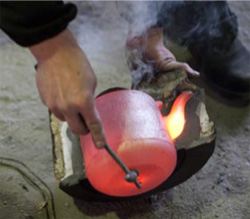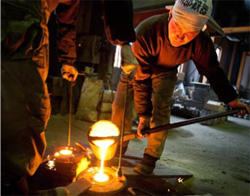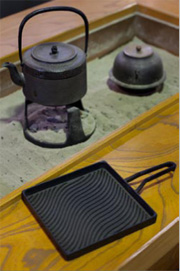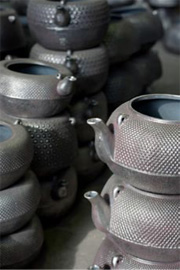Home > Highlighting JAPAN > Highlighting Japan MARCH 2012 > Not Just Any Old Iron
Highlighting JAPAN
JAPAN BRAND
Not Just Any Old Iron
Morioka in Iwate Prefecture is the home of one of Japan's signature crafts, ironworking. Having adapted its traditions to the times as well as to different markets, teakettles and other cast iron goods produced at the Iwachu Casting Works are now revered around the world. Gavin Blair and photographer Jeremy Sutton-Hibbert visited the foundry.

A craftsman opens a mold to retrieve a red-hot cast iron teapot.
Credit: JEREMY SUTTON-HIBBERT
The black colors of the teakettles that had been in use in Japan for centuries were unappealing to European tastes and the company had struggled to rack up overseas sales of any significance. Taking the advice of the Frenchman, Iwachu began to produce teakettles and pots in shades of blues, reds and greens that would have no doubt raised more than the odd eyebrow amongst the craftsmen who founded the company. The company went on to collaborate with European designers on new ranges, and within a decade exports were making up half of Iwachu's sales.

Craftsmen prepare the molten iron, prior to casting.
Credit: JEREMY SUTTON-HIBBERT
"One of the reasons that the industry flourished in this area was because the Nanbu region had good quality iron ore and other natural resources needed for production," explains Yayoi Iwashimizu, the executive vice-president of Iwachu.

The award-winning Pro Arte Series grill pan (foreground) and kettles, on display at Iwachu Casting Works
Credit: JEREMY SUTTON-HIBBERT
Like many traditional industries, Iwachu grapples with the challenge of maintaining the artisanship that defines it, while adopting sufficient modern production methods and contemporary designs to allow it to survive as a viable business in a global marketplace.

Enamel paint is applied to the iron kettles and lids using a straw brush and then baked onto the surface over heat.
Credit: JEREMY SUTTON-HIBBERT
"We design new ranges and products aimed at the tastes of people in the various markets we sell in," says Iwashimizu. "For example, our pots are popular in Korea, while the teapots are used more in Europe and the United States, and in China they like the tea kettles."
Iwachu also has a modern factory employing sixty people, where automated production speeds up the many laborious processes traditionally used in creating the distinctive Nanbu ironware. The company also maintains an old-style workshop where visitors can watch craftsmen make its iconic kettles the way they have been made for centuries. Some concessions to modernity are made even here: an electric smelting device cuts down to thirty minutes the three hours needed to melt the iron with a wood-fired heater.
"It takes about a week to make a teapot the way it's done here, from start to finish by hand," says Iwashimizu. "The workers have to train for ten years before they can attempt to take just the written test to become a certified traditional craftsman. And their training doesn't end there."
If you are lucky enough to get your hands on a piece of Nanbu ironware with the craftsman's name engraved on it, then you know you have something created by a true artisan: for they have toiled for at least three decades to earn the right to leave that signature.
© 2009 Cabinet Office, Government of Japan






